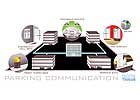
Talk about a vertical market! It doesn’t get any more vertical than a multi-story office building soaring over a city center. But such buildings make up only one segment of the property management market, which also includes:
- Mid- and low-rise buildings.
- Multi-building campuses.
- Multi-location retailers.
- Parking structures.
- Mixed-use facilities with commercial, retail and residential space.
“It’s definitely a growing market,” says Karen Evans, president and general manager of Sielox, Runnemede, N.J., an access control solutions manufacturer. “High-rise residential is exploding as major cities convert many old buildings to high-end residential units. Three- to four-story multi-tenant commercial properties are expanding, particularly in suburban areas, and they use a lot of access control.”
Tenants as Architects of Security
Advanced Electronic Security (AES), a Philadelphia security systems integrator, works with high-rise and multi-building campus property managers primarily. “A key difference between this market and others is that security is driven more by tenants than security directors,” says Jason Jackson, vice president of operations. AES recently completed installation of a StopWare visitor management system and Gunnebo Omega optical turnstiles for a 30-plus story Philadelphia office building because tenants wanted more tightly controlled access. Adds Evans, “Tenants can be much more receptive to security than employees in a one-owner building. Many don’t want to be in a building that lacks security.”Another differentiator of this vertical market is the fact that, in many cases, there are no on-premises security directors. As a result, integrators need to take time to educate property managers about security technologies and applications. Demonstrations are important because they can quickly show property managers the differences in performance between what they have and a proposed new system.

Networked-ready DVRs enable property managers to observe camera locations remotely on a PC.
Getting in on the Ground Floor
Earning business in the property management market begins the same way it does in every market: By listening to customers and responding with solutions that address their goals and challenges. Property managers want to implement a security plan that cost-effectively:- Protects people.
- Protects assets.
- Minimizes liability.
- Helps attract and retain tenants.
“Our main challenge is leveraging technology to stabilize or reduce manpower costs,” says David Levenberg, vice president of security and loss prevention, General Growth Properties, Chicago. “Tenants pay a fixed amount monthly, and, even if expenses go up over a year, the money we collect does not.” That doesn’t mean property managers only look for the lowest price. “Price is big, certainly,” admits Joe Gargan, security director for Republic Plaza, a 57-story office building in downtown Denver owned by Brookfield Properties. “But our first concern is what system best meets our needs and is compatible with existing equipment.”
Compatibility with legacy systems is important, but James Rothstein, senior vice president, Tri-Ed, an independent distributor of security, low voltage and home automation products, Woodbury, N.Y., also advises integrators to help property managers “future-proof” their facilities. “Not everyone has IP infrastructure now,” he says, “but it’s being more widely adopted as property managers take steps to consolidate operations. Property managers want the systems they’re investing in today to work with IP in the future.”
That was a key consideration when Gargan needed to replace card readers throughout his facility. “We chose smart cards and readers,” he explains, “because we believe these are the wave of the future. They are the standard for government agencies that may locate in buildings like ours. Plus, the property management industry is always changing and smart cards can accommodate future changes.”

Optical turnstiles such as these from Smarter Security create a secure perimeter just inside a building, are less intimidating than security guards, encourage tenant badge use and manage building visitors.
A Blueprint for Success
What does it take to build property management business as a dealer or integrator?-
Communication and value. AES’ Jackson says, “If there’s a problem, you may talk with the property manager or a tenant. That puts you in the middle of a building’s operation, so it’s important to share information. Also, emphasize the value-added services you can offer that can help bring in new tenants.”
-
Reliability and responsiveness. Gargan expects his integrators to respond to problems within four to six hours during the business day and four hours after hours. “If service isn’t timely,” says Evans, “property managers will find another business partner. The good news is that, if you’re performing well, property managers will take you to their next building and refer you to others.”
-
Partnering with IT. Chris Coffin, CEO, Digital Acoustics, a Lake Forest, Ill., manufacturer of IP intercom and paging solutions, advises integrators to “Learn who else is sharing the IT pipe with security and what other components and services are part of the bundle.”
- Expertise. Security professionals should look beyond the electronics and software of access control to gain the confidence and business of property managers, suggests Rick Geringer, vice president of marketing for manufacturer SDC, Westlake, Calif. “Stay abreast of changes in the openings industry, including types of non-fire rated and fire-rated doors and frames, fire-rated door hardware and building codes.”

Parking application using a Digital Acoustics IP intercom and paging solution. This can be used in a single location (LAN) or multiple locations worldwide (WAN).
If you don’t have property management experience, but want to explore business opportunities in this vertical, two places to start are the Building Owners and Managers Association (BOMA) or Institute of Real Estate Management. To find your local chapter, go towww.boma.orgorwww.irem.org. You might also tap a distributor for help in getting up to speed on the market, meeting manufacturers, training on systems and developing specifications for property management applications.
Sidebar: Two factors driving growth in property management are:
-
Increasing IP deployment. “IP is growing strongly in multi-building and parking structure situations because it enables property managers to remotely manage and effectively communicate with multiple facilities from one location,” describes Chris Coffin, CEO, Digital Acoustics, a Lake Forest, Ill., manufacturer of IP intercom and paging solutions. “We have a retail customer with shops in three states who wanted to run them centrally from a fourth state.”
- Tenant demand. “Property managers showcasing buildings to prospective tenants are putting more emphasis on security features, such as card access and CCTV,” comments Tom Heenan, vice president, business development, MAC Systems, Inc., a Canton, Mass.-based systems integrator. “Tenants demand safe and effective security for their employees and clients, so having up-to-date, state-of-the-art building security systems helps lease vacant space.”
Sidebar2: The Foundation Technologies
Access control. These systems, often including visitor management, are used extensively by property managers to secure buildings, elevators, parking garages and loading docks — and appeal to existing and prospective tenants. Tom Heenan, vice president, business development, MAC Systems, Inc., a Canton, Mass.-based systems integrator, calls access control “a must” based on tenant expectations. Karen Evans, president and general manager of Sielox, Runnemede, N.J., adds that access control is often offered as a tenant amenity. “Tenants don’t have to plan and locate their own standalone system,” says Evans, “and property managers feel they have better control over their facilities. Our system has been popular with this market for years because it doesn’t require facility codes. Property managers don’t need to maintain a card base history and can simply order cards off-the-shelf to accommodate new tenants.”Cameras and DVRs.These are deployed in facilities large and small. James Rothstein, senior vice president, Tri-Ed, Woodbury, N.Y., expects more NVRs to come on the scene because they offer more capabilities than DVRs and greater ability to work on networks. “NVRs are enterprise ready,” he says. But he believes there will continue to be strong demand for DVRs because of features such as motion detection.
Behavioral, or pixel, analytics is a DVR feature that attracted the attention of Joe Gargan, security director for Republic Plaza office building. “We can’t expect security guards to spot everything when they’re looking at 50, 60 or more cameras over an eight-hour shift,” he states. “But, if a camera changes pixels when something happens, and alerts guards to review it on a separate monitor, they can determine the appropriate response.”
Rothstein expects to see more of another type of DVR — hybrids that work with analog and IP cameras. “These will enable dealers to future-proof installations,” he says. “Even if you’re installing analog cameras today, you can add IP cameras later and your customers can use their existing DVRs.” IP cameras currently cost about four times more than analog, but Rothstein anticipates prices coming down soon, facilitating more widespread adoption in smaller installations.
Electronic locking devices.These devices play a huge role in building security, determining the physical integrity of doors and a property’s code compliance. Rick Geringer, vice president of marketing for SDC, the Westlake, Calif., manufacturer of access control hardware, says, “Use of electrified lever locksets for office doors, stairwells and exits is increasing while electromagnetic lock use has slowed.” He attributes this to the superior aesthetics, manual egress and higher security of electrified mortise and cylindrical locksets compared to exposed or vulnerable magnetic locks and electric strikes. “Electrified locksets also comply with building and safety codes applicable to fire-rated doors,” he comments, “including high-rise stairwell and elevator lobby doors where electric strikes and magnetic locks are prohibited.”

Sidebar: One Lincoln Street
Canton, Mass., systems integrator, MAC Systems, provided base building security for One Lincoln Street, a 36-story, “class A,” Boston high-rise with an additional four floors of parking space below grade. The building’s security components, installed during construction in the early 2000s, include:- Access controlled doors and elevators.
- CCTV cameras throughout the exterior and interior, including elevator cabs.
- DVRs.
- Digital photo ID system for tenants and staff.
- Visitor ID management.
- Intercom system serving the general building, parking garage, emergency stairwells and elevator systems.
MAC Systems provided project management, programming and testing, applications engineering (detailed AutoCAD drawings, equipment submittals, value-added recommendations), training and subcontractor supervision for the project.
